It seems like the people of Vijayanagar empire had deep faith in religion and gods, and constructing magnificent and architecturally advanced temples were their way to express this faith and creativity. The result is a large number of temples with varied size and styles spread across Hampi.
Let me first put the map of sacred center of Hampi, taken from hampi.in.

Vitthala Temple:
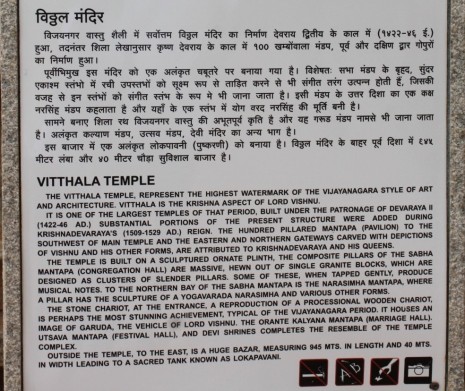
In the hub of temples across Hampi, our first stop was the renowned Vitthala temple. This temple, dedicated to Lord Vishnu, is not a single temple – It’s a huge temple complex. The entire area is a consortium of multiple structures, built at a short distance from each other and enclosed inside a walled campus.
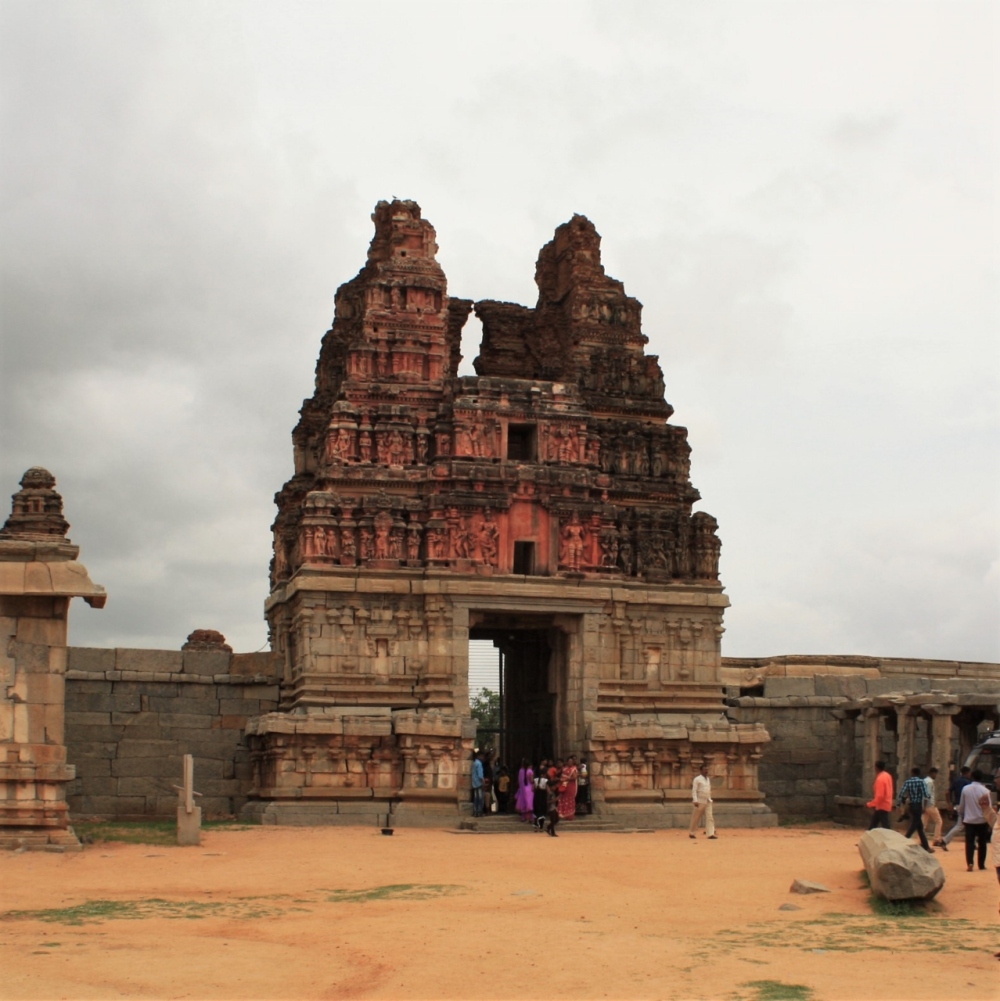
The temple is located in the north eastern part of Hampi, near the banks of the Tungabhadra River.
Unlike most structures, which are just few feet away from the main road, Vitthala temple is around a km or so off-road and no private vehicle is allowed to go near it. Thanks to the battery operated vehicles that ply on this route and quickly port you to and fro the temple. While sitting in this vehicle, you could enjoy the views of remains of bazaar on both sides of the mud road that runs till the temple’s east gate, where the ticket counter is located.
Now about the ruins of bazaar – During the Vijayanagar kingdom rule, bazaars or markets were the hub of all commercial activities. History tells us that the empire was so prosperous that gold, diamonds and precious gems were sold in open market in measuring jars. Also, since trading was prevalent during that time, cotton, spices and textiles were traded with Europeans against many things including horses.
These bazaars were built only outside temples and were well-planned structures, comprising of series of pillared pavilions, some of which were two-storeyed. The four major temples all had bazaars in front of them. Virupaksha or hampi bazaar is opposite Virupaksha temple and is the one which is still in good condition, while all others are in ruins. The other bazaars are the ones opposite Krishna temple, Vitthala temple and Achyuta Rayas temple. source

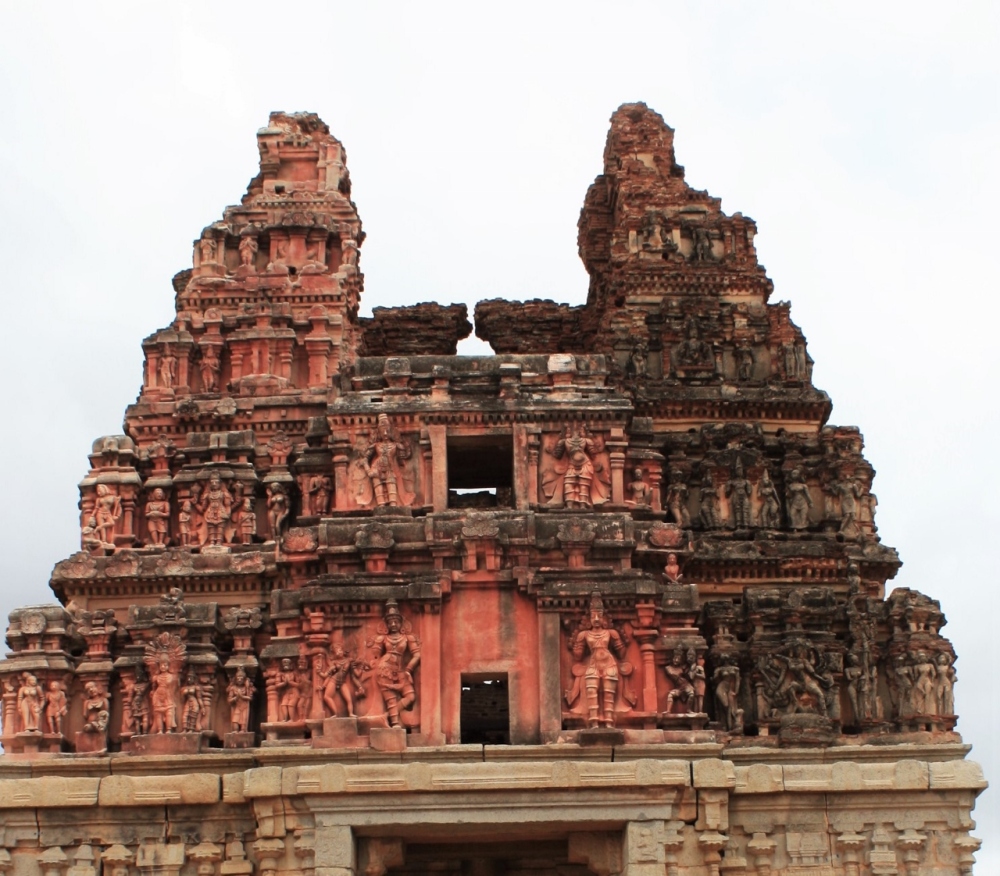
A huge temple gate (gopura) visible from a distance is partially burned but the intricate carvings are still prominent. As you will enter the gate, you will find a symmetric layout of 4 spectacular structures, 3 of which are pillared temple-like (one in center flanked by the other two on left and right side) and the 4th one is an ornate stone chariot right in the center of the compound.
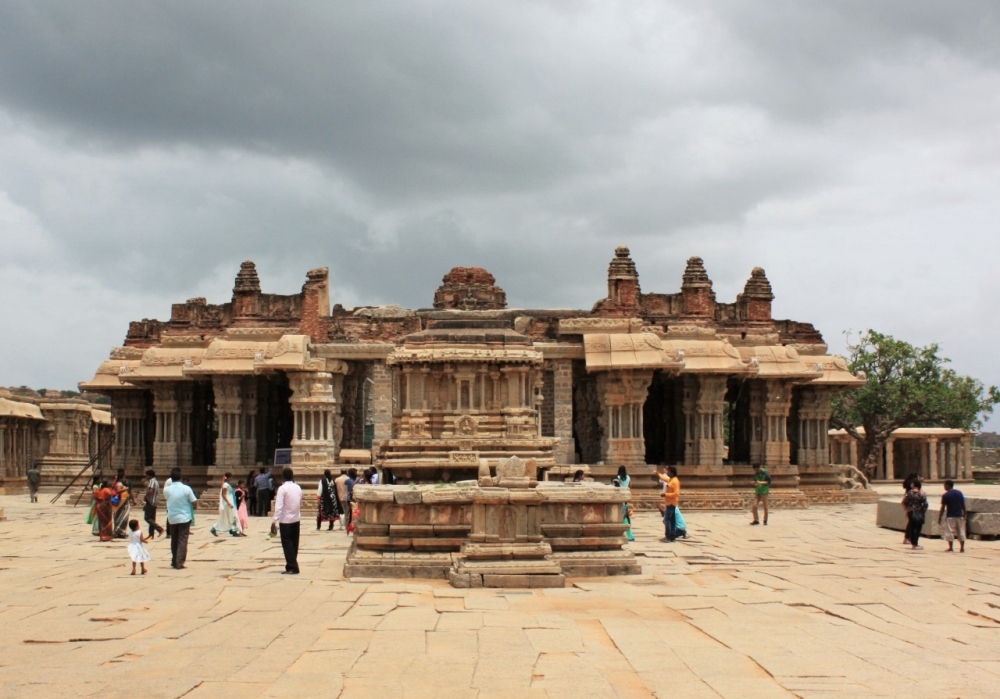
As we entered the complex, the guide started speaking about the history of the place and I simply could not focus. I was so lost in the beauty of the place, all I could think of was to run close and touch and feel every carving. The feeling is actually hard to describe. Anyways, I decided to calm my nerves and to listen to what the guide was explaining. Our first stop was the famous stone chariot.
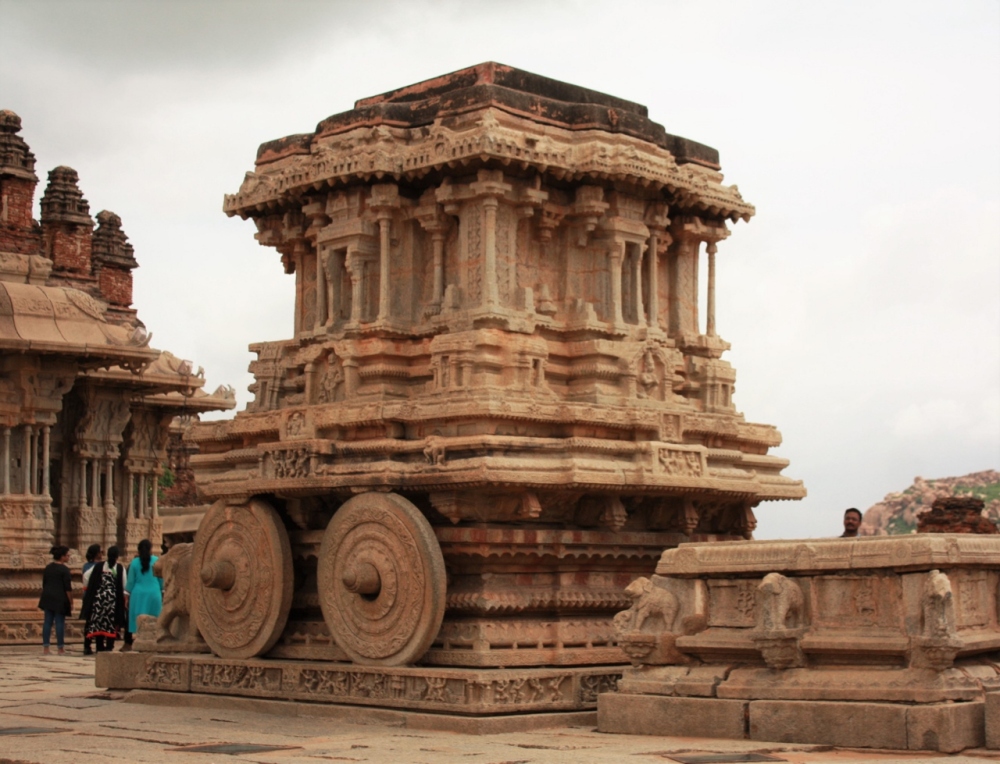
There are actually three stone chariots in India (Hampi, Konark and Mahabalipuram) and here I was, standing in front and witnessing the glory of one of them.
The history tells us that this beautiful structure was built by King Krishnadevaraya in the 16th century. The structure is said to be actually a shrine which once contained the idol of Garuda. As is normally seen in Hindu temples, a small temple of the god’s vehicle is established just outside and in front of the main temple, the same trend is visible in all the temples in Hampi. So, this small shrine in the form of a beautiful chariot was built for Garuda, vehicle of Lord Vishnu, right in front of the main temple, Mahamandapa and faces its sanctum.
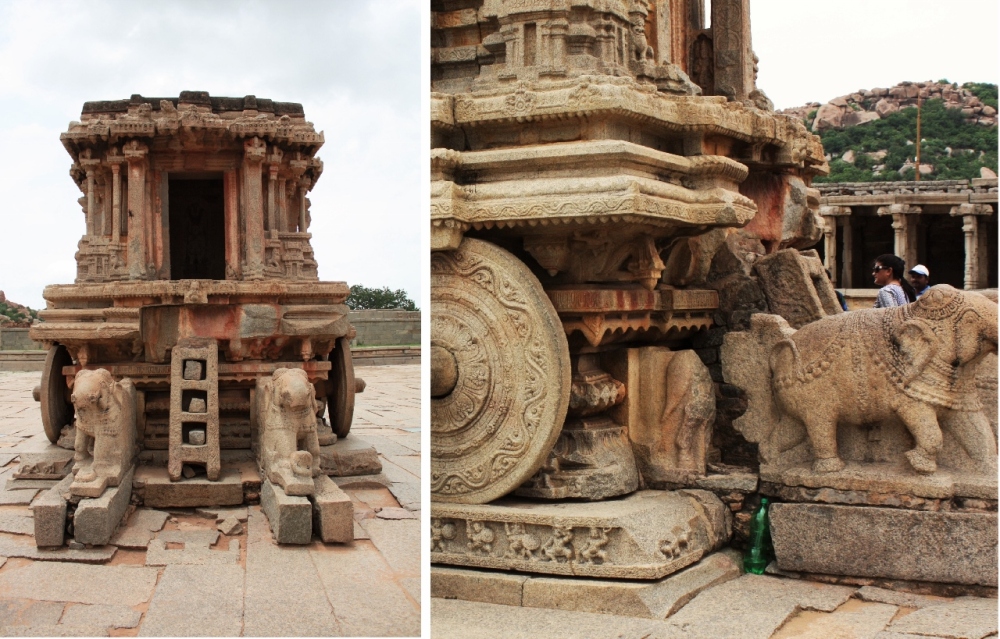
The Stone Chariot was built in the Dravidian style of architecture and appears to be a monolithic structure but was actually built using multiple granite blocks of huge size.
The chariot is built on an exquisite platform of about one foot high. The four giant wheels are attached to it. The wheels used to rotate in the past until a few years back government got them cemented to prevent the rotation and hence the damage. Both the platform and the wheels are ornated with carvings of scenes from mythical battles and floral motifs.
There are two elephants structures in front of the chariot. It is believed that earlier there were horses as part of the chariot itself but they got damaged over the course of time. The elephants structure were then brought and kept in front of the chariot to complete it (see the picture above). The tails and the hind legs of the horses are visible behind the structures of the elephants even now.
There is also a stone ladder standing between the elephants, that was once used to access the sanctum of the shrine. It is now blocked with stones .
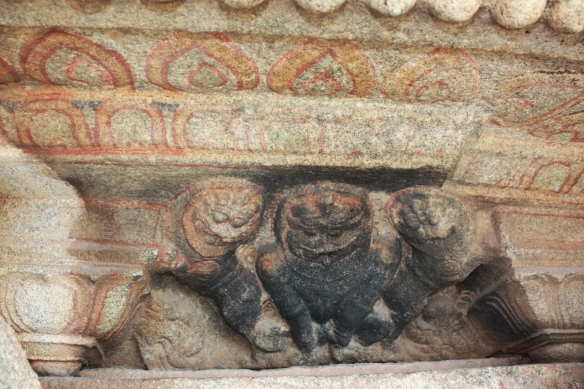
We moved ahead to see the main temple, known as Mahamandapa of the Vittala Temple, the one which houses the famous musical pillars. The restoration work was going in full swing and most of the area inside was blocked from entering. We zoomed our cameras inside and somehow managed to capture the stunning carvings which uniquely define the structure.
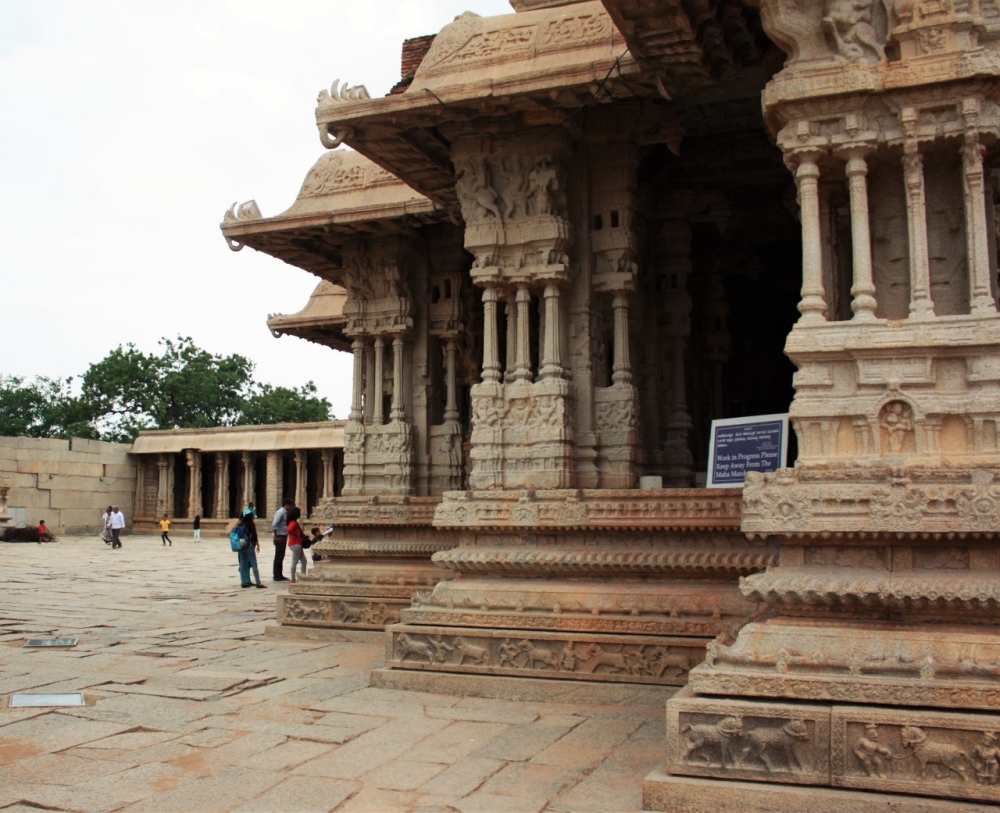
The Mahamandapa, meaning main hall, comprises of 4 small halls. The highlight of mahamandapa is huge monolithic composite pillars. While the inside pillars have intricate carvings and sculptures, the outer ones have short slender mini pillars carved out in the center. These miniature pillars are said to emit musical tones, though they are not allowed to touch these days, to prevent further damage.
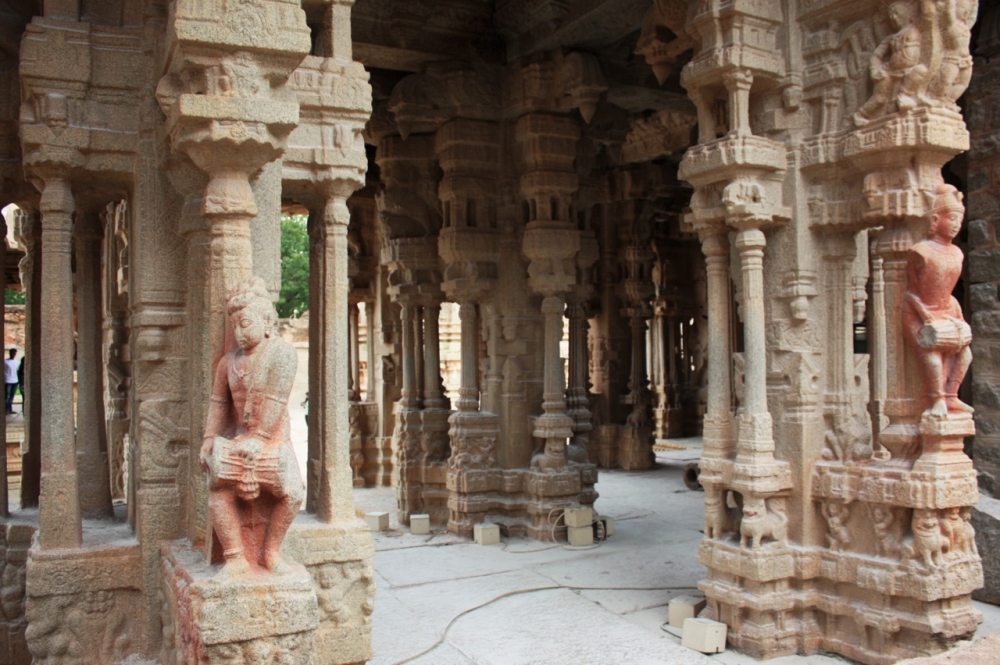
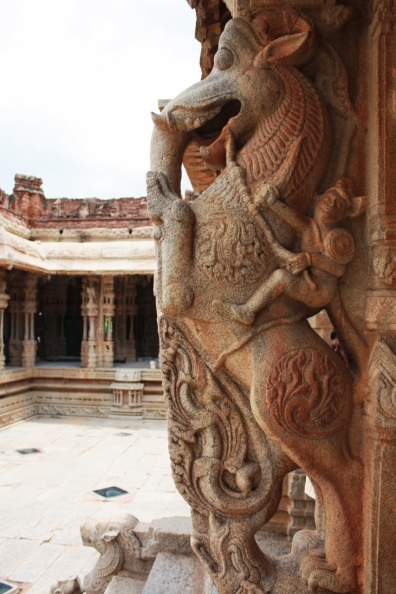
Out of the four small halls, the center one is open and damaged, the eastern one has outer pillars as musical pillars and inside with sculptures of drummers and dancers.
The southern hall pillars mostly depict the mythological creatures yalis, while the northern hall pillars have Narashimha sculptures.
The other main mandapa in this temple complex is Kalyana Mandapa or the marriage hall. Entire hall has carvings of mythological events, and the pillars are sculptured with soldiers riding yalis.
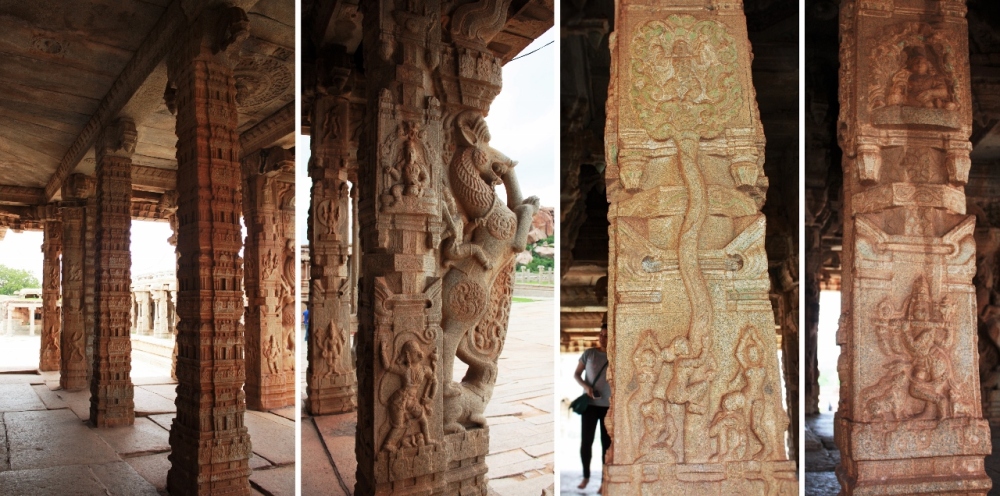
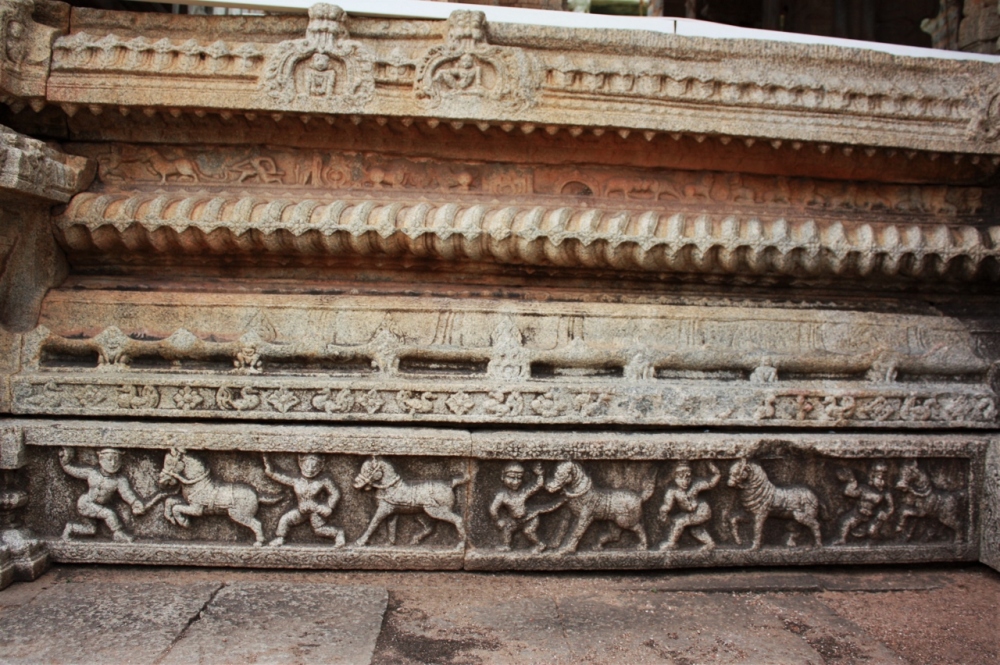
After visiting Vitthala temple, we moved ahead in our journey and stopped next at Kadalekalu Ganesha temple.
Kadalekalu Ganesha
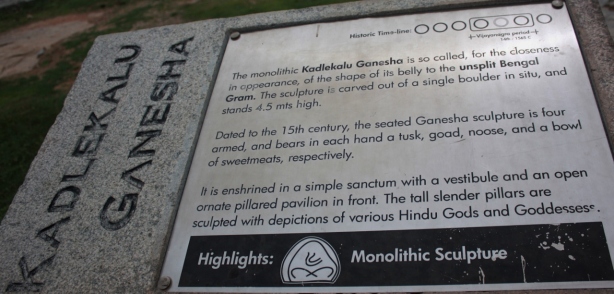
Here you will see a giant monolithic statue of Lord Ganesha, inside a sanctum. Outside there is pillared hall with mythological carvings. The place is at a height, so provides a good view of the surrounding area, especially the gopura of Virupaksha temple and hampi bazaar.
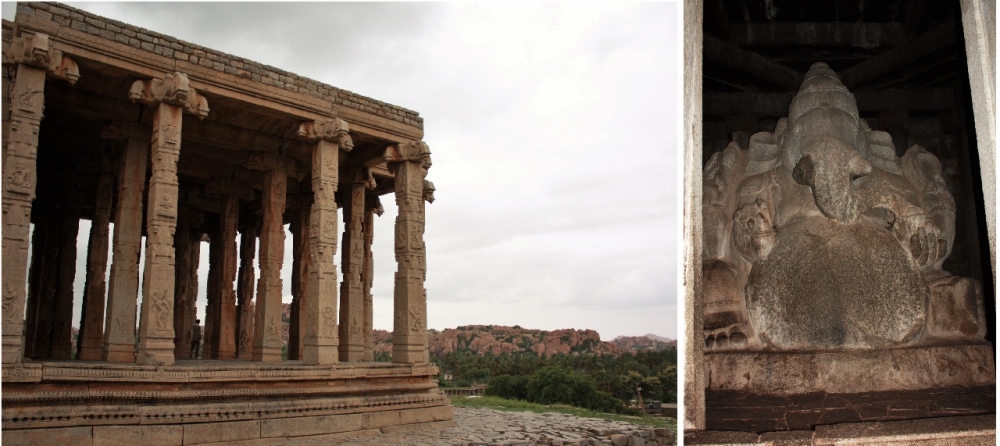
Lakshmi Narasimha Temple
Just little off the road, there is a narrow path that takes us to two prominent sites, Lakhsmi Narasimha (or Ugra Narasimha i.e. Narasimha in its terrifying form) temple and badavilinga temple, adjacent to each other.
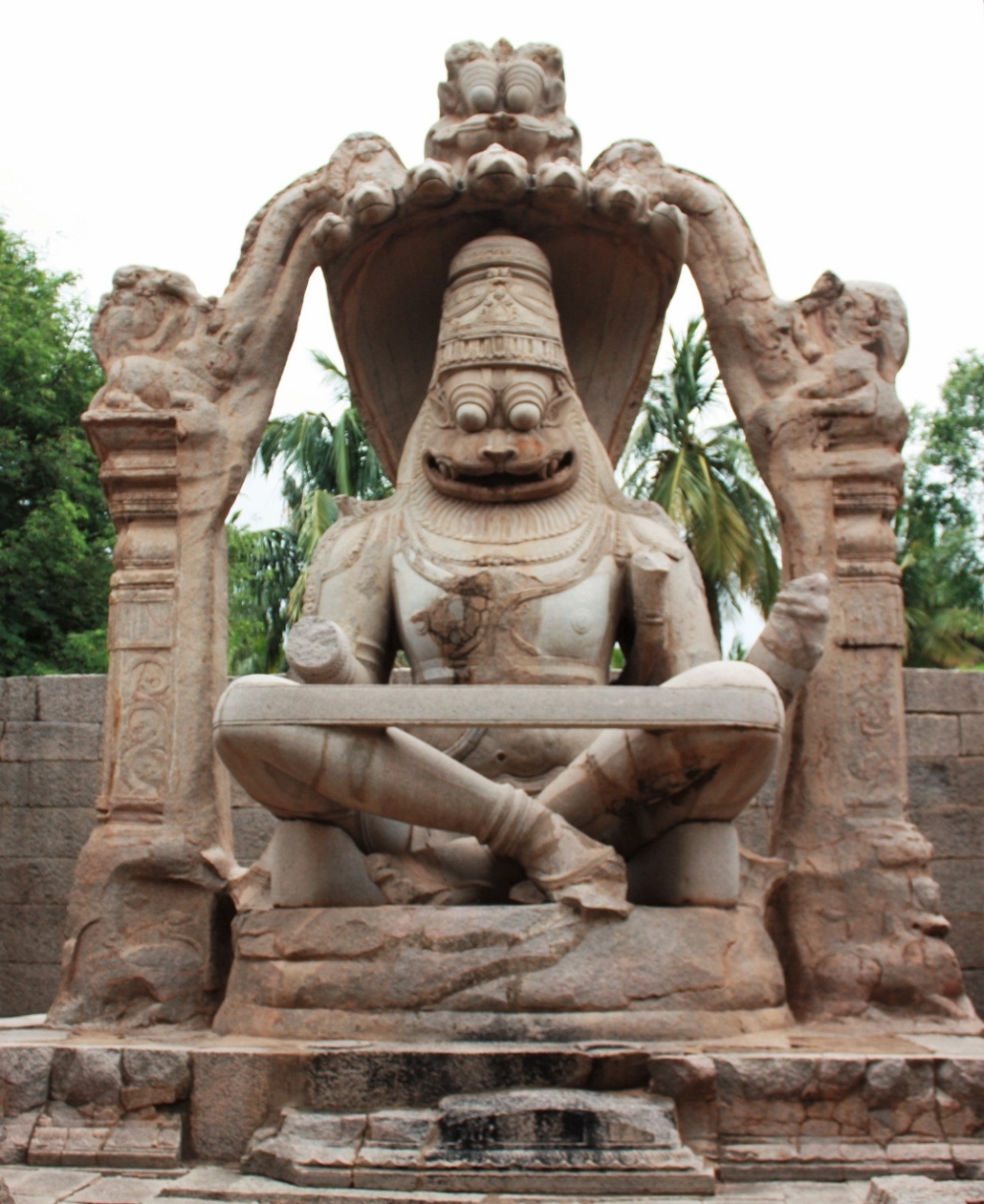
Lakshmi Narasimha statue is a giant monolithic statue which is largest in Hampi. The protruding eyes are looking towards where there was once lakshmi statue, that got damaged during destruction.
Badalinga temple is a small shrine housing a huge Linga inside a closed chamber. The chamber or sanctum is filled with water and lower part of linga is immersed in it.
Virupaksha Temple
Our next stop was Virupaksha temple, situated in the heart of Hampi, amid the bustling activities of locals and tourists (this is near the bus stop and main hampi market). The gopura is high enough to be visible from a distance.
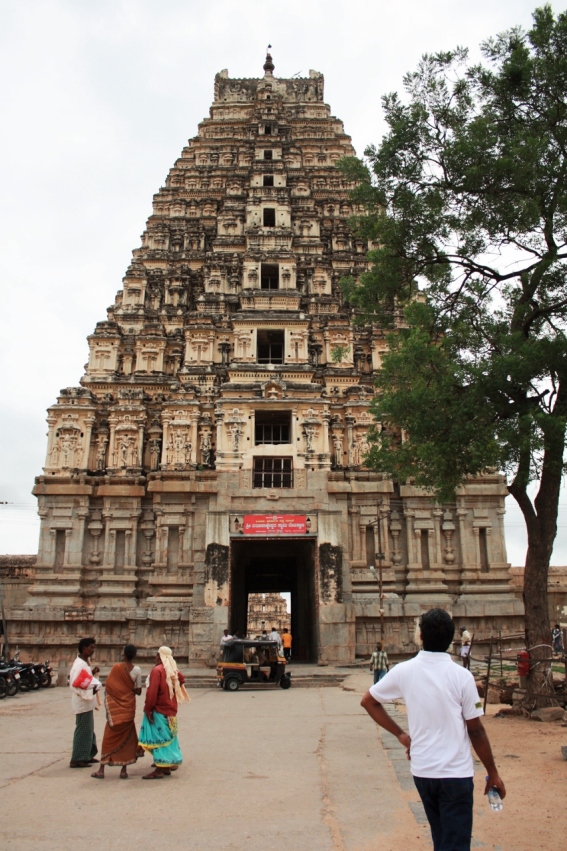
Virupaksha temple is the only ancient temple in Hampi which is still used for worshiping. The temple is dedicated to Lord Shiva and is considered the most auspicious place for weddings by the locals. According to the folklore, Lord Shiva married Pampa at this place where the temple was later built and hence the belief.
The entrance or the gopura of the temple is a tall exquisite structure at the end of what is known as Hampi Bazaar. The bazaar is in ruins but believed to be the biggest trading ground during the Vijayanagar empire.
As you will enter the grand gopura, you will see a large open courtyard, at the end of which there is another entrance (gopura), considerably smaller. The ticket counter is right before this second entrance, while on the right there is a pay-and-use area to keep your footwear.
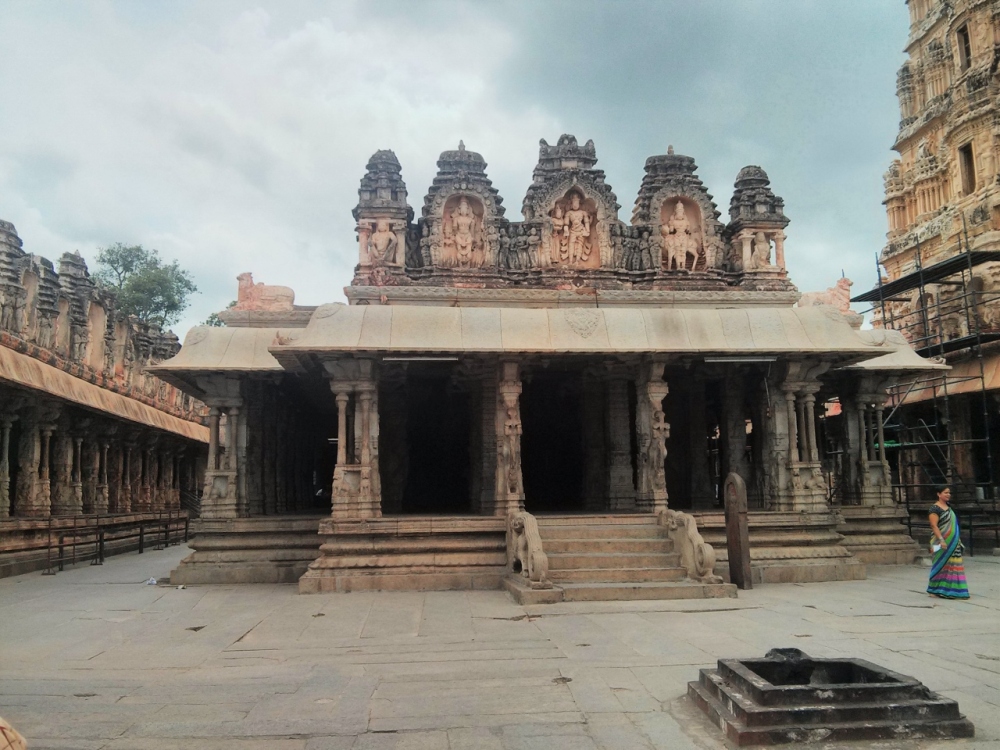
On entering the second entrance, you will see the main temple in the center, a pillared hall on the left and an administrative offices on the right. The famous temple elephant Lakshmi could be seen inside the pillared hall on the left.
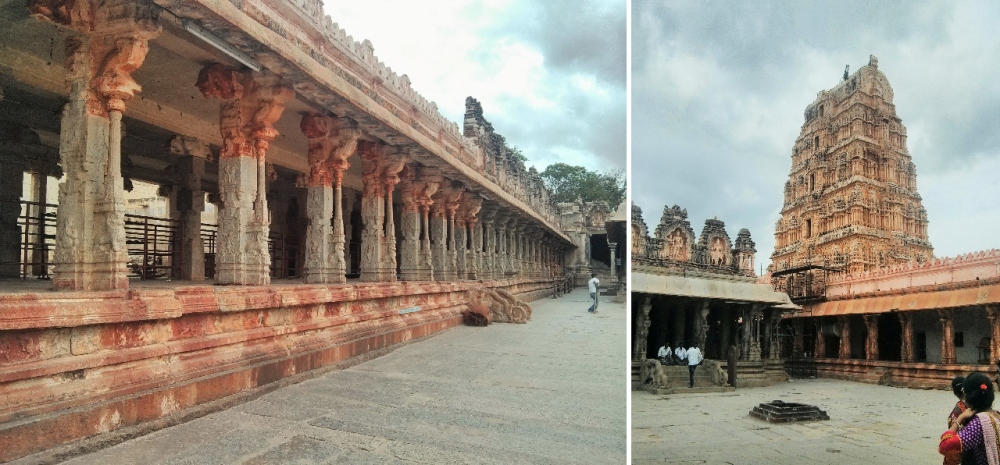
We went straight inside the temple which comprises of a pillared hall, three ante chambers and a sanctum. The pillared hall is the most ornate structure and is believed to be constructed during the King Krishnadeveraya reign. Lost in the beauty and the narration by the guide, I forgot to click the pictures of the inside carvings.
In the evening, we climbed the Mahatanga hill to see the sunset. It is not an easy climb, so be cautious. The view of entire Hampi from the top is simply amazing.
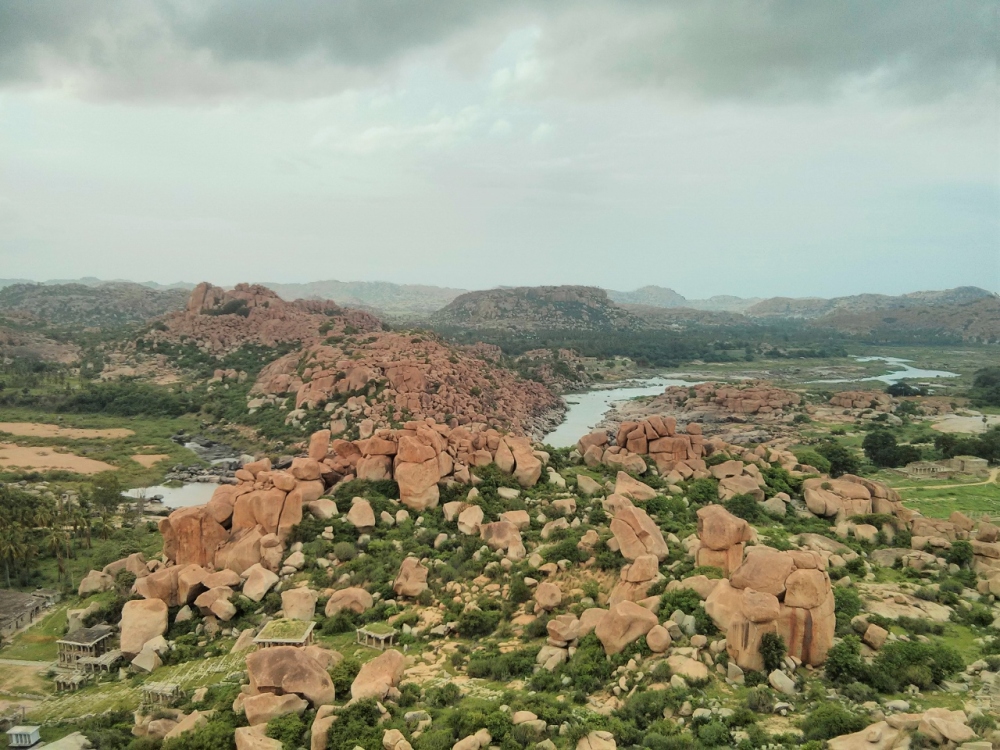
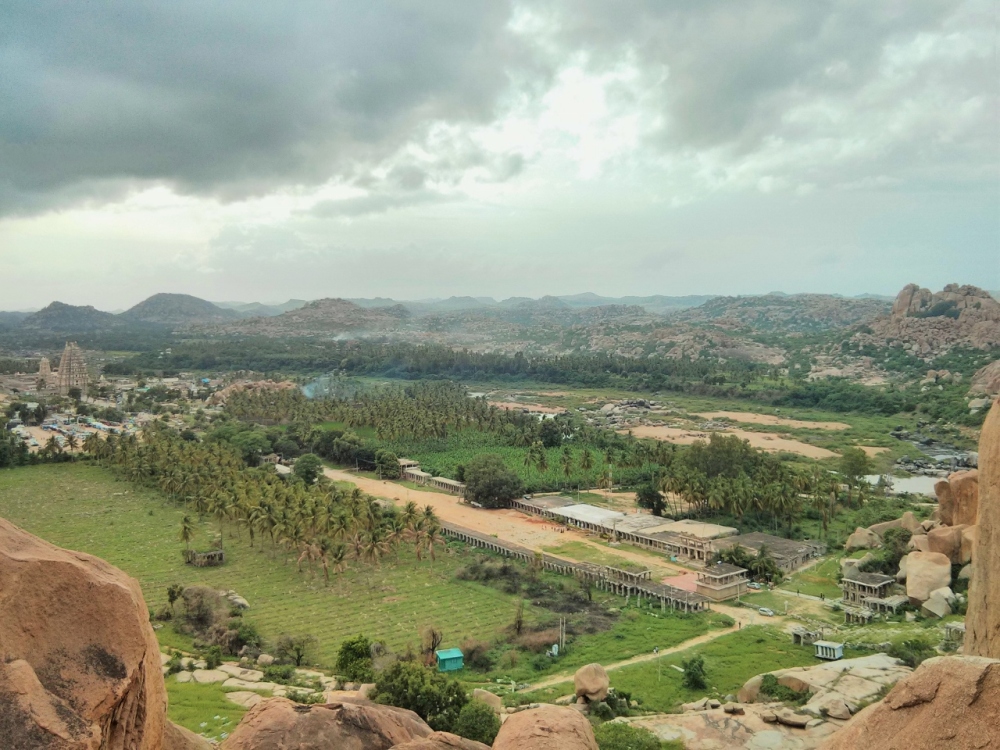
Practical Info:
Don’t forget your sunglasses, caps, and water, otherwise heat will drain your energy.
Do carry a map or list of places. Guides are usually experts in making you miss many places. As you can see there are many more temples, such as Achyuta Raya’s temple, Krishna’s temple and others which we missed due to ignorance. Plan to visit these places too.
As I mentioned in previous post too, plan to spend at least two days in Hampi to experience the beauty of the place at a comfortable pace.
Hampi Bazaar near Virupaksha temple has many eateries. We ate our lunch at a restaurant called mango tree.There are also many small souvenir shops in the bazaar.
Useful links:
http://www.pickpackgo.in/2015/08/hampi-virupaksha-temple.html
https://anushankarn.blogspot.in/2011/03/hampi-part-4-virupaksha-temple.html


Hi! You have a very interesting travel blog. The thing that I liked the most about your blog is – that you have taken out time to write and not just post pictures – one after the other. Good work, dear. Keep it up!
Love
Yamini
https://lifeonweekends.com/
Hi Yamini,
Thanks for stopping by and sharing some good motivating words. Thw blog started from my love of baking and sharing the modified recipes with my friends. But soon baking got diminished and travelling experiences took front stage. happy that you liked it. I saw ur website. its fabulous, definitely gonna refer before visiting the places you have written about. Thanks again:)
Keep writing!
Yeah, your words have just motivated me enough to forget laziness and post those which have been lying in draft from some time. They are about my recent trip to Thailand. I will now soon publish them.Thanks 🙂